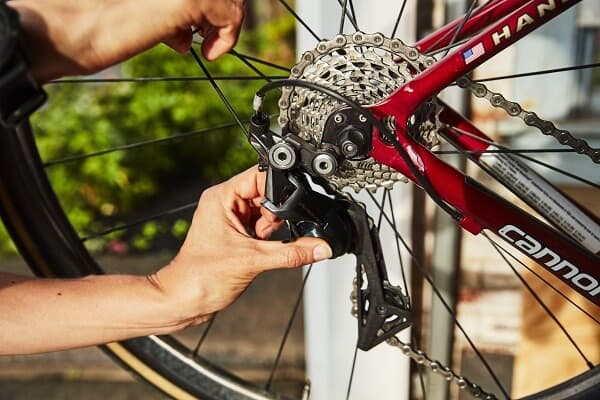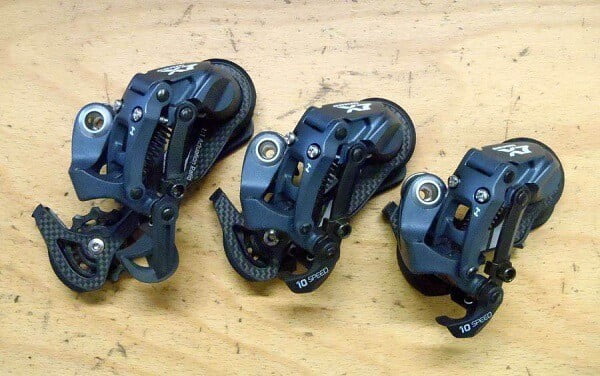What is a Rear Derailleur?

Image Source: bicycling.com
Before we get into the calculations, let us briefly discuss what a rear derailleur actually is? Rear derailleurs are a tool that provides the mechanism which shifts the chain from one cog to another on your bicycle’s cassette that is located at the rear. The handlebar’s gear shifter of the bike tugs on a cable which actually moves the derailleur. Then the derailleur shifts the chain to the next cog of the cassette. A derailleur plays an essential role in your drivetrain. It is definitely one of the most important components of your bicycle. Therefore, you should make sure that your derailleur is compatible with all the parts of your bicycle to receive the best performance.
Any bicycle with multiple gears comes with a rear derailleur. There are of course a few exceptions. For example, the inner gear hubs do not require rear derailleurs. In addition to rear derailleurs, some bikes also accommodate front derailleurs. They are used to move among the double or triple chainrings. Most of the road bikes come with both a front & rear derailleur. However, they are not that common on mountain bikes. This is because mountain bikes utilize the 1X system which does not require a front derailleur. Instead, it utilizes a front chainring. This was introduced by SRAM but now it is available in products built by almost all the brands.
What is Cage Length?

Image Source: mtbdirect.com.au
Rear derailleurs are available with cages of different lengths. This is done to make it compatible with different varieties of slack chain produced when shifting occurs between the small and large chainrings. But you might be asking what is the cage length? It is simply the length of the upper pulley to the lower pulley of the derailleur.
A high amount of slack can be generated when you shift to the smaller chainrings if your rear cassette consists of a huge range between its large and small cogs, or even if the front crankset has a big gap between the size of the chainrings. This is where a derailleur with a longer cage length will come in handy. A longer cage size will be able to occupy much more slack to tighten the chain.
You will find that mountain bikes mostly utilize long cage derailleurs. Likewise, road bikes that have triple chainsets also use long cage derailleurs to adjust to the high difference that will be there between the large and small chainrings.
The Calculation Process of the Drivetrain Capacity
Now that we know about rear derailleurs, let us dive ride into the calculations. The total drivetrain capacity of the rear derailleur is basically the highest quantity of slack chain that the derailleur cage can accommodate. And the higher the quantity of slack, the larger the derailleur cage needs to be. The overall gearing range of your bicycle is often referred to as the drivetrain capacity or also the tooth capacity. A lot of the time it is even called the drivetrain tooth capacity. Regardless of what you choose to call it, you can find it by first calculating the difference between the smallest and largest front & rear gears. After that, you can add these two values and get your results. Let’s take a look at an example so that you can understand it better. Let us go through this step by step to get the whole idea.
- Firstly, you must calculate the maximum chainring difference. You can do this by deducting the number of teeth between the largest and smallest chainring. Let us say that the largest is 44 and the smallest is 22, then we get 22.
- Secondly, you must calculate the maximum cassette cog difference. This can be done by deducting the number of teeth between the largest and smallest cassette cog. Let us assume that the largest is 32 and the smallest is 11 which gives us 21.
- Now you can find out the total drivetrain capacity by simply adding the maximum chainring difference and the maximum cassette cog difference. And the final result is 43.
You should also note the maximum cassette cog.
The final result is a total drivetrain capacity of 43 which means that this requires a long cage derailleur. However, a long cage derailleur may not be exactly the case. This is because there are a few more factors that you need to take into account. First of all, derailleurs for mountain bikes mostly consist of a greater capacity when compared to derailleurs for road bikes. Second of all, different derailleur brands have different cage length capacities. And last but not least, there are significant differences among different models of derailleurs and their different versions even if they are produced by the same brand.
We know all this can seem a bit confusing, especially if you have been introduced to derailleurs and their capacities recently. However, there is no need to worry. Below, we have provided a few basic setups that can help you understand more about this topic.
First, let’s discuss road bikes. If you have a road bike then you might want to consider the following options:
- If you have a rear cassette that ranges from 13 to 26 and has front chainrings of size 53/39, then you should choose a small cage derailleur.
- If you have a rear cassette that ranges from 11 to 26 and front chainrings of size 53/39, then you should go for a medium cage derailleur
- If you have a rear cassette that ranges from 11 to 42 and also a front chainring of size 52/36, then you will require a long cage derailleur.
Now for mountain bikes. If you have a mountain bike then you should consider one of the following options:
- A ratio of 12-23 on your rear cassette with a front chainring of 36/26 will require you to get a small cage derailleur.
- A range of 12-32 rear cassettes along with the front chainring of 36/24 will allow you to opt for a medium cage derailleur.
- If you have an 11-42 ratio on your rear cassette accompanied by a front chainring of 38/24, then a long cage derailleur will be right for you.
- Also, an 11-42 rear cassette accompanied by a 1X system chainring on the front, then a medium cage derailleur will be a great fit.
We are not stating that these options will be an exact match. These options are just to give you a better idea of how to get the correct derailleur cage size for your bike.
Conclusion
We hope that we have been able to provide you with the information that you were looking for. Our mission is to add value to your life so that you can get the best and the most fulfilling cycling experience. And we hope this article is successful in achieving that mission. So we wish you all the best for you and your cycling journey ahead. Take care and stay safe!

been cycling seriously for 70 years and have found that cage length is important more important is length from frame fix point to centre of upper guide pulley.Have seen cases where, with say a 34 cog the pulley clashes with the underside of such a large cog.Novice riders need to be aware of this.M.Hulme ,Blackpool.